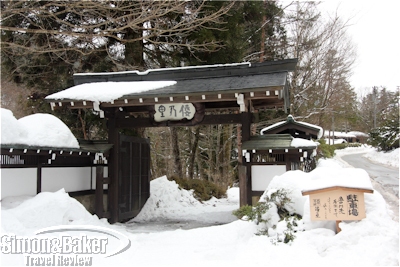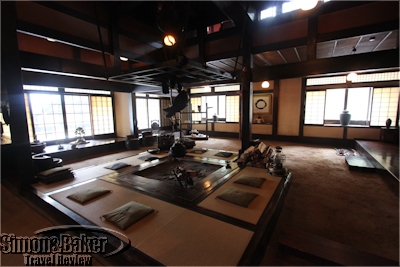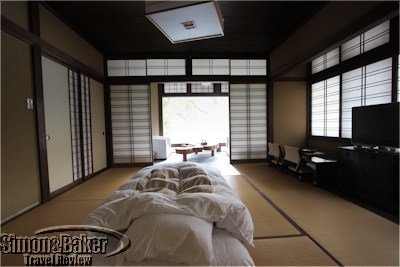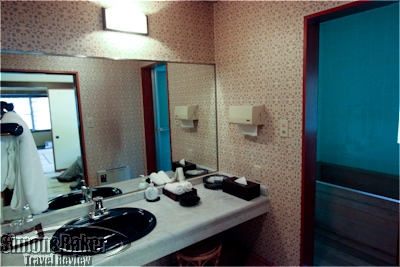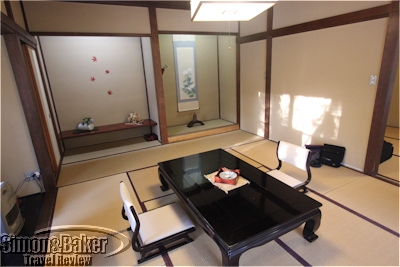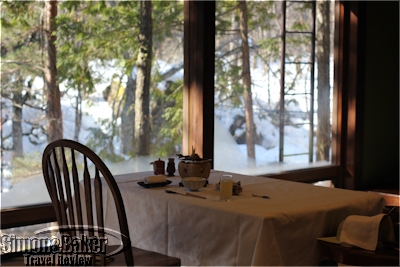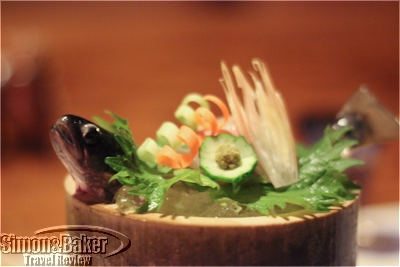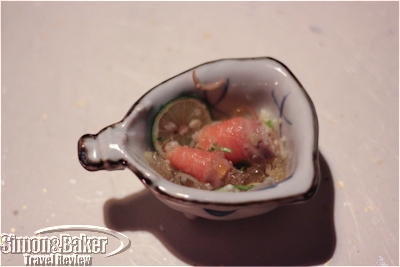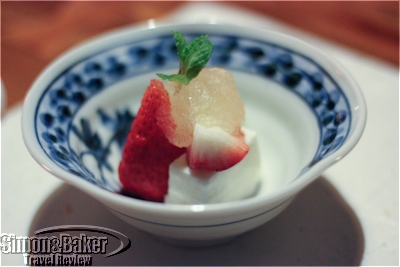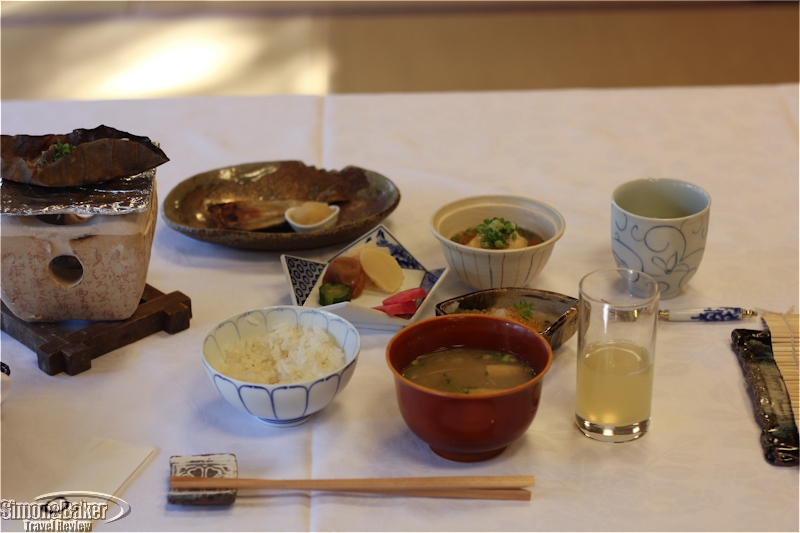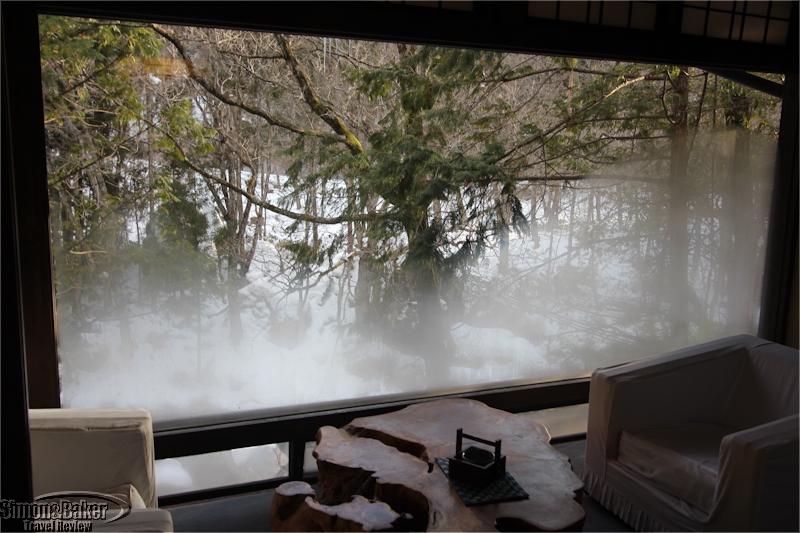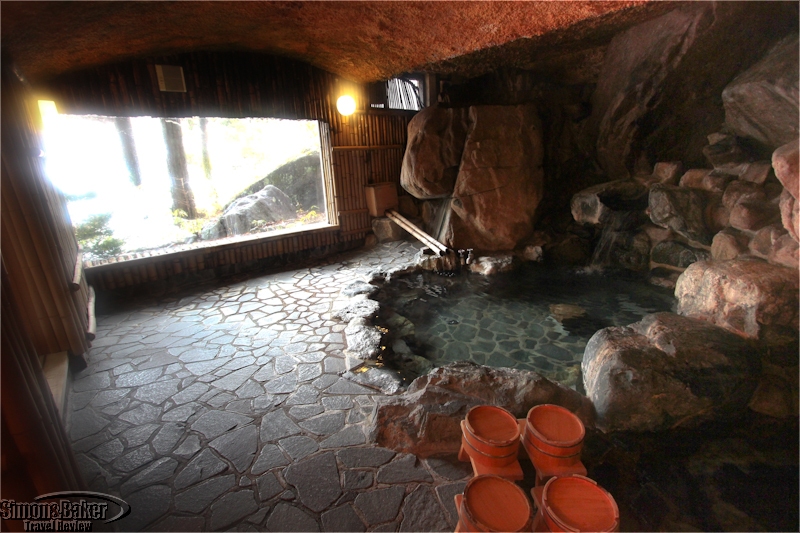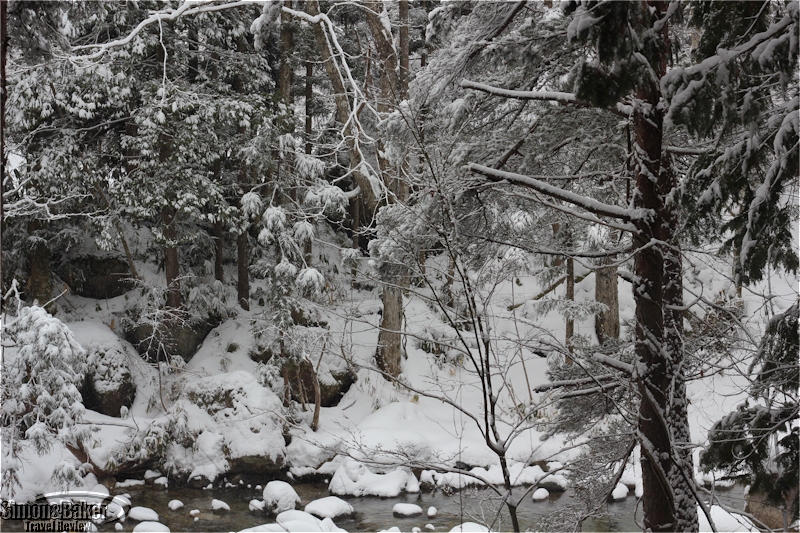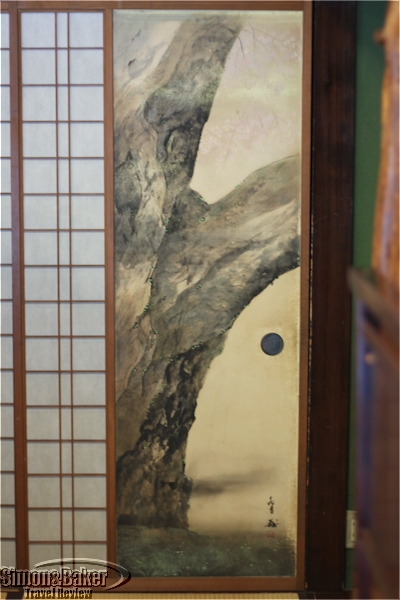
Out of the dozen or so ryokans I have encountered in Japan, Wanosato was of one of the best I have stayed in. The inn, although recently built, was modeled after old traditional Japanese architecture of the area: houses called minka (house of the people) with thatched roofs called gassho-zukuri (praying hands style) and earthen walls. The property had four cottages to choose from. I stayed in the main building that also contains wonderful public baths and a lobby area with a traditional hearth in its center. Here I relaxed, dined, bathed, and appreciated outstanding examples of a variety of Japanese arts.
Dinner and breakfast were provided, as is customary at ryokans. I was served fine Japanese cuisine that included locally grown mountain vegetables and fish caught only hours before in the Miya River. At every dinner I indulged in Hida beef, the highest grade of beef in Gifu, an area known for its cow muscle. If fact, Hida beef tasted as delicious as its more famous cousin from Kobe.
The Wanosato service was superb. Although only one staff member I met could communicate in basic English, each and everyone at the inn made me feel at home. I felt as if I were visiting long lost relatives here. Their service sprouted from the heart.
Class Of Accommodation Luxury ryokan
General Manager Naoe Kabeya
Handicapped Access No
Internet Connectivity I was able to access the internet with Wanosato’s Wi-Fi network. Although the staff warned me that reception might not be good, and that I might have to go to the lobby for a strong signal, I connected my iPad and MacBook without issue.
Length Of Stay Three nights
Location Wanosato is situated in the center of Japan, accessible from the major cities of Tokyo and Osaka. Travel time between Tokyo Station and Wanosato was about five and a half hours. While over five hours of traveling time might sound daunting, I was rewarded with a scenic train ride during the last leg of the trip from Nagoya to Takayama Station. The train meandered around gorgeous terrain, alternating between sleepy towns and majestic mountains. After I arrived at Takayama Station, Wanosato provided a complimentary 20-minute shuttle to the property.
Owned And Managed Yoshihiro Matsuda of Chiyoda-Kankou-company, Ltd.
Pets No
Size The inn employed six staff and had 15 rooms divided among four traditionally styled cottages called minka on a 15,000 square meter property. The main building had six rooms.
Year Opened-Most Recent Renovation Opened in 1992. Although no recent renovations were mentioned, I thought the property was well maintained.
The hallmark common area of a ryokan, in my experience, is its public baths. As is usually the case in ryokans, baths were separated by gender. Wanosato staff invited me to visit both when no other guests were using the facilities to appreciate the difference between the two. Here the women’s bath won out: I dipped in two natural stone pools: a piping hot one and a cooler one nearby. The men’s bath was more straightforward, but equally relaxing: it had one large pool encased in a wooden bath. Both baths featured striking views of the Miya River.
Room I stayed in Miyanoma, a spacious room with a breathtaking view, and filled with great examples of Japanese art. It measured 28.5 square meters and was located on the second floor of the main building. It was divided into a sitting room, a main room where I slept, and a bathroom. The main room and sitting room featured views of the Miya River. I felt as if I were staring at a Hokusai print by the famous ukioy-e woodblock print artist, framed by the large windowpanes. Tatami, bamboo reed mats, covered the room while fine samples of Japanese scrolls hung from the walls. It was a natural style of accommodation that made me feel transported back in time. However, the room also had modern conveniences: if it were not for the heating technology in the room, I would have felt very chilly. The room also had two gas heaters, a kotatsu, a heated table with blankets in the sitting room, and heated floors in the main room. There was a medium-sized closet with two yukatas, cotton Japanese robes, a TV, refrigerator with drinks, tea set, electric kettle, telephone, and a Japanese style table near the main window. At night, the staff set out a single sized Japanese futon where I slept. It was soft and comfortable.
My first dinner was an 11 course tour of local foods: a yamayasai or mountain vegetable appetizer; sesame tofu with mountain roots; tofu soup with white radish; local Iwana fish with vinegar miso; three succulent slices of Hida beef; yuzu, a Japanese citrus fruit, sorbet; smoked Iwana; manju, a rice-based sweet, with lily root; fried Iwana skin, salmon sashimi wrapped in Yuzu jelly with a rice porridge, and finally strawberries with a citrus jelly and mint leaf for dessert.
The following morning I had a Japanese style breakfast, which usually involves vegetables, rice, fish, and miso soup. Wanosato provided a nice surprise: candle heated miso atop a banana leaf with two bamboo shoots that resembled a small bunny. I also enjoyed julienned apples with a spoonful of jelly and mint leaf on top.
Five courses arrived for my second dinner. I had locally brewed sake and grilled katsuo fish with grated bonito flakes; abalone sashimi; Hida beef nabe, or Japanese hot pot cooking; vegetable tempura, and a fruit with jelly dessert.
The next day, my stomach called for an easy to digest breakfast. The chef knew exactly what to cook and prepared some Japanese healing foods. I had a soothing basic rice porridge with miso soup.
My final dinner was a superb version of Japanese sukiyaki, thin slices of the spectacular Hida beef slowly cooked in a pan with vegetables. With a beautiful array of ingredients including tofu, scallions, Chinese cabbage, konyaku jelly noodles, shitake mushrooms, and onions, Aya Tochimoto, a Wanosato staff member, helped cook the meal. Thinking about each egg soaked bite of beef and vegetables makes my mouth water to this day.
Before I departed Wanosato, my stomach craved Western style foods. The chef obliged and baked croissants, whipped a green tea smoothie, and assembled a fruit plate of strawberries, bananas, apples, yuzu, and mint leaves. My stomach was well comforted before hitting the road.
Facilities There were public baths and a dining room.
Date Of Review February 2012
Reviewers Article and Copyrighted Photos by Joachim Castellano
Service The service at Wanosato was top notch. Although as a non-Japanese speaker I had difficulty communicating at times, not many words were necessary for the staff to anticipate my needs. During my stay I fell ill and it was in part as a result of staff’s warm concern and menu adjustment that I regained strength.
Would You Stay There Again? Yes
Contact Information
- 1682 Ichinomiya-cho
- Takayama-shi
- Gifu-ken
- Japan 509-3505
- +81 577 53 2321
